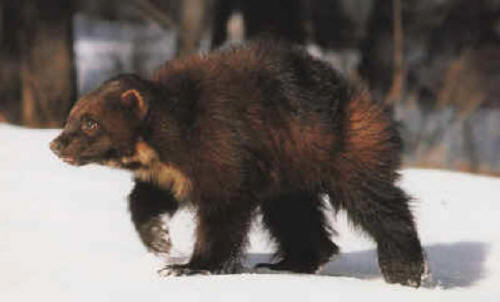Wolverine (an animal related to the badger)


The wolverine (Gulo gulo), also referred to as glutton, carcajou, skunk
bear, or quickhatch, is the largest land-dwelling species of the family
Mustelidae (weasels). It is a stocky and muscular carnivore, more
closely resembling a small bear than other mustelids. The wolverine has
a reputation for ferocity and strength out of proportion to its size,
with the documented ability to kill prey many times its size.
The wolverine can be found primarily in remote reaches of the
Northern boreal forests and subarctic and alpine tundra of the Northern
hemisphere, with the greatest numbers in northern Canada, the Alaska,
the Nordic countries of Europe, and throughout western Russia and
Siberia. Their populations have experienced a steady decline since the
19th century in the face of trapping, range reduction and habitat
fragmentation, such that they are essentially absent in the southern end
of their European range. It is, however, estimated that large
populations remain in North America and northern Asia. Wolverines are
solitary animals.
Anatomically, the wolverine is a stocky and muscular animal. With
short legs, broad and rounded head, and small eyes with short rounded
ears, it resembles a bear more than other mustelids. Though its legs are
short, its large five-toed paws and plantigrade posture facilitate
movement through deep snow.
The adult wolverine is about the size of a medium dog, with a length
usually ranging from 65–107 cm (26–42 in), a tail of 17–26 cm (6.7–10
in), and a weight of 9–25 kg (20–55 lb), though exceptionally large
males can weigh up to 32 kg (71 lb). The males are as much as 30% larger
than the females and can be twice the female's weight. Shoulder height
is reported from 30 to 45 cm (12 to 18 in). It is the largest of
terrestrial mustelids; only the marine-dwelling sea otter and giant
otter of the Amazon basin are larger.
Wolverines have thick, dark, oily fur which is highly hydrophobic,
making it resistant to frost. This has led to its traditional popularity
among hunters and trappers as a lining in jackets and parkas in Arctic
conditions. A light silvery facial mask is distinct in some individuals,
and a pale buff stripe runs laterally from the shoulders along the side
and crossing the rump just above a 25–35 cm (9.8–14 in) bushy tail. Some
individuals display prominent white hair patches on the throat or chest.
Like many other mustelids, it has potent anal scent glands used for
marking territory and sexual signaling. The pungent odor has given rise
to the nicknames "skunk bear" and "nasty cat." Wolverines, like other
mustelids, possess a special upper molar in the back of the mouth that
is rotated 90 degrees, towards the inside of the mouth. This special
characteristic allows wolverines to tear off meat from prey or carrion
that has been frozen solid. |
